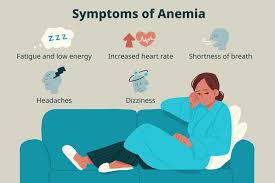Do you ever feel like you’re running on empty? No matter how much sleep you get, you can’t seem to shake off that tired feeling. Well, you’re not alone. Many teenagers in Kenya, especially those between the ages of 10 and 14, are facing a common but often overlooked issue; Anemia.
Anemia might sound like a big, scary word, but it simply means you don’t have enough red blood cells or your red blood cells don’t work as they should. Your red blood cells are responsible for carrying oxygen throughout your body. Oxygen powers your cells and gives you energy. Without healthy red blood cells that do their job, your body doesn’t get the energy it needs to function. Red blood cells contain iron-rich protein Hemoglobin, which is necessary for transporting oxygen form lungs to cells and tissues.
Iron deficiency is estimated to contribute to approximately 50% of all cases of Anemia among women worldwide. Iron is essential for immune response for cognitive development, temperature regulation and overall work performance. And let’s face it, being tired all the time can really put a damper on things, especially when you’re trying to focus in class or have fun with your friends. Adolescent anemia is a prevalent issue, particularly among school-going adolescents aged 10 to 14 years. Anemia can have significant consequences on a young person’s physical and cognitive development, impacting their academic performance and overall well-being.
In this guide, we will delve into the causes of adolescent anaemia, its effects, and, most importantly, nutritional strategies to manage and prevent it. So, why are so many teens in Kenya dealing with anaemia? Well, it boils down to a few key factors. For starters, adolescents are at an increased risk of developing anaemia due to increased iron demand during puberty, menstrual losses, limited dietary iron intake, and faulty dietary habits. This dramatic increase in iron requirement among adolescents’ peaks between the ages of 14-15 years for girls and one to two years later for boys—the requirement for iron doubles during adolescence as compared to the younger age group. But that’s not all. There are several factors contributing to adolescent anaemia, with nutritional deficiencies being one of the primary causes.
In Kenya, inadequate intake of iron rich foods such as leafy greens, beans, and meat, coupled with a lack of access to clean water and sanitation facilities, exacerbates the prevalence of anaemia among adolescents. In addition, parasitic infections such as malaria and hookworm infestations further deplete the body’s iron stores, leading to anaemia.
Now, you might be thinking, “So what if I’m a little tired? What’s the big deal?” The truth is anaemia can have some serious consequences, both physical and mental. The effects of adolescent anaemia extend beyond physical symptoms, impacting cognitive function and academic performance. Fatigue, weakness, and dizziness are common physical manifestations which can hinder a student’s ability to concentrate in class and participate in extracurricular activities.
Studies have shown that teens with anaemia often struggle with things like impaired memory, reduced attention span, and decreased learning capacity, highlighting the need for timely intervention and management.
Nutritional Management Strategies:
Poor nutrition is often associated with inadequate intake of healthy foods and can result in multiple micronutrient deficiencies, such as iron, folic acid, vitamin A and vitamin B12. During adolescence, requirements for iron, vitamin A, calcium, zinc and vitamin D increase. Consuming fortified foods and supplements can help provide the essential micronutrients that adolescents need, especially when access to a healthy, diverse and nutrient rich diet is neither feasible nor affordable. The relevant World Health Organization recommendations for the provision of additional micronutrients pertaining to all adolescents encourage fortification of staple foods and oral supplementation. These recommendations include fortification of maize flour and corn meal with vitamins and minerals; fortification of food-grade salt with iodine for the prevention and control of iodine deficiency disorders; and efforts to detect and ensure optimal serum and red blood cell folate concentrations in girls.
Nutritional management plays a pivotal role in combating adolescent anaemia. Encouraging adolescents to consume a balanced diet rich in iron, vitamins, and minerals is essential for addressing nutritional deficiencies. Incorporating locally available foods such as dark green vegetables, legumes, nuts, and fruits into daily meals can help boost iron intake.
Additionally, promoting dietary diversification and educating adolescents on the importance of nutrition for overall health and academic performance are crucial components of effective management strategies. And remember to stay hydrated! Drinking plenty of water throughout the day can help keep your energy levels up and your mind sharp. Plus, it’s important to avoid things like sugary drinks and junk food, which can zap your energy and leave you feeling even more tired.
But it’s not just about what you eat and drink – it’s also about making sure you’re taking care of your overall health. That means getting plenty of exercise and getting enough sleep. Recent studies emphasize the importance of community-based interventions and school health programs in addressing adolescent anaemia in Kenya. A study published in the Journal of Nutrition Education and Behavior highlighted the effectiveness of school-based nutrition education programs in improving iron intake and reducing anaemia prevalence among adolescents.
Conclusion
In conclusion, adolescent anemia is a significant public health concern in Kenya, particularly among school-going adolescents aged 10 to 14 years. Addressing this issue requires a multifaceted approach that includes nutritional management, access to clean water and sanitation facilities, deworming initiatives, and community-based interventions. By prioritizing nutrition education, promoting dietary diversity, and implementing evidence based interventions, we can effectively manage and prevent adolescent anaemia, ensuring better health outcomes and academic success for Kenya’s Adolescents.




